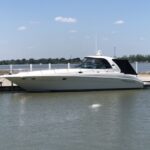Cummins Marine Diesel Repower Specialists › Forums › General Discussion › Engine Oil Temperature
- This topic has 15 replies, 5 voices, and was last updated 2 years ago by
 Tony Athens.
Tony Athens.
-
CreatorTopic
-
January 1, 2022 at 6:35 pm #124604
FRANK A SILKWOODParticipantVessel Name: Oregon
Engines: 6BTA, 370
Location: Anacortes
Country: United States
I just read another article stressing the importance of engine oil temperature for reducing coking in the engine. I gather oil temperature should be well above that for water temperature.
I have a 6BTA 370 but there is no oil temperature gauge. I thought it would be good to add one, but was surprised I could not find anything on the Seaboard Marine web site.
Suggestions?
-
CreatorTopic
-
AuthorReplies
-
February 22, 2022 at 7:01 pm #127313

Tony AthensModeratorVessel Name: Local Banks
Engines: QSB 6.7 550 HP
Location: Oxnard, CA
Country: USA
Temps are right where they should be running 180 stats………..As long as you have redundant coolant temp alarms / raw water flow alarms and they work, you are good .. Running on plane with just factory alarms is scary in my book knowing haw fast things happen on any 6BTA 5.9 HIGH HP Cummins.. If there is something you want to attach–Send it to me and I’ll add it you your post
February 22, 2022 at 6:07 pm #127308
FRANK A SILKWOODParticipantVessel Name: Oregon
Engines: 6BTA, 370
Location: Anacortes
Country: United States
I just can’t figure out how to attach a file. I have tried twice. The file shows after selection, but not after submitting. I have tried .pdf,.xlsx and .doc.
This time I’ll try with a different browser.
February 21, 2022 at 7:18 pm #127245
FRANK A SILKWOODParticipantVessel Name: Oregon
Engines: 6BTA, 370
Location: Anacortes
Country: United States
Sorry there was no attachment with the temperatures. I’ll try again.
I took a set of temperatures with an infrared thermometer. One at my lower normal cruse speed of 8 Kn and one at about 12 Kn. Both with the thermometer held about 8 inches from the surface (about 1″ diameter sensing circle). See attached.
Like you said, oil temp seems hot enough?
Regards, Frank Silkwood
February 15, 2022 at 7:20 pm #126912
Tony AthensModeratorVessel Name: Local Banks
Engines: QSB 6.7 550 HP
Location: Oxnard, CA
Country: USA
Nothing attached??? I would like to see what you recorded–I have not been that anal about it..
I just always used my hand and I away find the oil pan to be MUCH HOTTER than the valve cover and expansion tank, after all is stable…
February 15, 2022 at 11:58 am #126889
FRANK A SILKWOODParticipantVessel Name: Oregon
Engines: 6BTA, 370
Location: Anacortes
Country: United States
Tony
I took a set of temperatures with an infrared thermometer. One at my lower normal cruse speed of 8 Kn and one at about 12 Kn. Both with the thermometer held about 8 inches from the surface (about 1″ diameter sensing circle). See attached.
Like you said, oil temp seems hot enough?
Regards, Frank Silkwood
January 5, 2022 at 8:35 am #124713
Rob SchepisForum ModeratorVessel Name: Tenacious
Engines: 6BTA 5.9 330's - "Seaboard Style"
Location: Long Island, NY
Country: USA
That’s funny Steve, I guess I like things “just so”
January 4, 2022 at 12:38 pm #124686
Steve LewisParticipantVessel Name: Just Us
Engines: Cummins 480CE
Location: Marblehead, OH
Country: USA
If I may……….
Some practical translation…………
Adding Wolverine oil pan heaters and running them every minute that the engines are not on will heat and maintain a higher temp in the oil, engine and by extension the engine compartment. You now are starting with oil that is higher in temp and lower in viscosity. thus easier to move to the important parts.
Rob says to ease the load onto the engine to get it up to operating temp. I have adopted a process for leaving the dock. Get everything ready, fire the engines at the last possible moment and then idle out into the channel that then leads to the inlet. I am running at 700 – 850 rpm depending on traffic for about 10 minutes. T-Stats are open at this point. Once I clear the inlet mouth we ease up to hull speed. For us that is 1130 – 1140rpm. I watch the oil pressure as that is what I have. As the oil warms, the pressure drops. The viscosity thing. Higher temp = lower viscosity = lower oil pressure. When I am happy and clear of the idiots in the general area I will throttle up to 2140rpm and get on plane. This is where I am getting the whole system up to full operating temp. At a minimum we are headed to our swimming hole(30 minutes) or to destinations father afield. Adopt your own process that works for you. Also use your hands to check for temps. I believe that Tony is trying to tell you that those temps should feel similar. Valve cover, Overflow tank and oil pan…..
I swear by anything and everything that the SBMAR Crew have to offer. I will place that higher on the list of wisdom(knowledge +experience = wisdom) than anyone else that “Publishes” their opinion. I am here to learn just like you are. I am still learning after 4 years.
Your process of running low and slow and then throttling up to get full operating heat in the system and burn it all out is the recommendation of this site.
Check out paragraphs 2 and 3.
When Tony mentions “all the other things that take a marine diesel out before its time” he is referring to the aftercoolers, heat exchangers and other coolers in the circuit. You are in salt water so tending to those should be higher on the priority list if they are not already. Fresh Water Flush is a low cost addition that returns a HUGE benefit.
@Rob – How did I know that you have a German sport sedan………..
1 user thanked author for this post.
January 4, 2022 at 5:33 am #124666
Rob SchepisForum ModeratorVessel Name: Tenacious
Engines: 6BTA 5.9 330's - "Seaboard Style"
Location: Long Island, NY
Country: USA
My car has an oil temp gauge. A few winters back it was a brisk morning at 9 deg F. I start my car in the driveway and let it run 10-15 minutes or so while I finish up my normal pre-departure routine….. then I drove ~10 miles to work which is mainly 30-45mph back country roads so about a 20 minute drive that I sometimes take at a very leisurely pace enjoying the scenery and my coffee, as I did on this particular day. So altogether the engine was running a good 30-40 minutes, the oil temperature barely creeped over 140F.
If I drive the car with any level of “enthusiasm” the normal oil temp reading is about midway between the 190 and 240 marks, so ~215F.
Moral of this story — Putting a load on the engine makes a real difference as to getting the oil temperature up. We always preach load should be added in stages as you come out of the harbor and this is another example of just that.
Frank, your worried about the oil temp in your Cummins with a coolant cooled oil cooler. — How about those seawater oil cooled Yanmar and Volvos, they must at times have really really low oil temperatures…………especially if they come out of the harbor and do nothing more than a simple bump of the throttle(s).
To answer your questions – under normal conditions, the oil temperature should be higher than the coolant temperature. The expansion tank will give you the coolant reference. As to the oil temp try the oil pan or the oil filter.
Remember there’s a right and wrong way to use an IR temp gun and several variables … angle of beam, distance to the target, reflectivity of the target. Good luck. Hope you’re able to settle your unsettledness and do keep us updated…
1 user thanked author for this post.
January 3, 2022 at 7:24 pm #124662
FRANK A SILKWOODParticipantVessel Name: Oregon
Engines: 6BTA, 370
Location: Anacortes
Country: United States
Thanks Tony.
When I check temps at the three points, what am I looking to find? Should the oil pan match or be hotter than the other two?
Not sure my hand is as sensitive as yours. I have a thermal thermometer. Would that be good to use?
Regards, Frank
January 3, 2022 at 6:41 pm #124659
Tony AthensModeratorVessel Name: Local Banks
Engines: QSB 6.7 550 HP
Location: Oxnard, CA
Country: USA
Frank,
This is not about anything to do with “smarter”.. It’s all about very long term experience dealing with Cummins marine engines–nothing else…As to Max P and his article–I have not read it, but is it based on current experience, or “old perceptions” carried forward from when Detroit 2-strokes ruled the roost? Actually, that doesn’t really matter anyway as no one can disagree that running “too cold” can create its owe uniquite issues, but again those “issues” are indentifable and would be long term consistant with that…
Now what really matters–YOU– If your coolant temps run at 180F or above when you are in your hours on end “slow mode” , you have ZERO issues with running too cold………This is IFFSO FACTO in my book.. Running a tad harder once in a while makes all those concerns even less of an issue.
Nest time you are out and the weather and conditions lead themselves–Do this—- let you hand learn these two temps.. The valve cover temp and the top/expansion tank temps.. Then compare those to side of your oil pan.. I’ll rest my case after that.. Drop Max P a note too.
Go fishing and don’t even think about all the rest.. You are good to go..
Tony
January 3, 2022 at 1:12 pm #124649
FRANK A SILKWOODParticipantVessel Name: Oregon
Engines: 6BTA, 370
Location: Anacortes
Country: United States
No way am I trying to be smarter than you. It is why I asked the question on the Seaboard site. I appreciate your experience.
It was an article by Max Parker in the current issue of Passagemaker about possible harm to engines from running too cool. It got me thinking about the issue and wondering why my engine did not have an oil temperature sensor, if oil temperature is most important, as he suggested.
I prefer to cruise at about 8 K/1400 rpm/+/- 2 gph. The water temperature is 180. If I bring it up to 80% of WOT, about 2400/12 K/+/- 10 gph, the water temperature is about 190 (I’ve never seen much above 190 for water). So plus 20 assumption for oil means about 210 for any operations at higher rpm. Is that hot enough, and how long did it take for all to be stable? Parker says to run higher rpm for 30 minutes at the start of an outing, and the higher temperature will linger. Per previous advice from a mechanic, I was running higher rpm at the end of a outing for about 15 minutes.
Any guidance would be appreciated. I don’t need to install a gauge if it won’t really help.
January 2, 2022 at 5:59 pm #124625
Tony AthensModeratorVessel Name: Local Banks
Engines: QSB 6.7 550 HP
Location: Oxnard, CA
Country: USA
Frank,
Clark is right as to gauges that will do what you want……………………………..But on a personal basis, I question your resolve as to the goal you wish accomplish in this “quest”…………………………………. In the 35 yrs I have dealt with the mid-range Cummins engine ( certainly have over seen of 1500 installations) I have NEVER seen the need to monitor the oil as to knowing its the temp in the pan ..<br />Never have I ever seen any issue even remotely related to that temp yet I have seen 100’s of engines go poo-poo” long before it was time related to everything else that I preach…..<br />But all that aside, a picture with notes is attached if you feel the need to pursue this endeavor…….. Without any hesitation I know that the oil pan temp will typically run not less than 20F above coolant temp once all is stable.. I’d use that as a guide, but this could always be tested by learning “your hand” on various components on the engine.. You’d be amazed on how your “hand” can tell you what the temps are in relation to each other.. Valve cover temp is typically around 10-15F less coolant temp on an engine once all is stable. Anything above 150F gets uncomfortable to hold on to for more than a few seconds. Now it’s your turn again.. Have I missed something in these past 30+ years? Have you, on your own, totally covered all the other things that have shown all of us way too many times as to what takes ALL MARINE engines out long before its time?
January 2, 2022 at 4:17 pm #124624
Clark LeighsParticipant******The gauge needs a sending unit. Is that also suitable for oil******
It should be however ask Seaboard themselves to be sure. These probes are metal construction.
Probe install should be into the oil pan side at an unused port. THat will take an examination. Again ask Seaboard. In the pan there will be no pressure to contend with.
On much older engine I had a probe and it was mounted in the side of the oil pan. It croaked some time ago and I have yet to replace it.
January 2, 2022 at 10:21 am #124615
FRANK A SILKWOODParticipantVessel Name: Oregon
Engines: 6BTA, 370
Location: Anacortes
Country: United States
Thanks. I saw those too. But, since they don’t indicate oil, I am a little uncertain. The gauge needs a sending unit. Is that also suitable for oil? Where does the sender screw in on the engine for a meaningful reading?
January 1, 2022 at 10:17 pm #124606
Clark LeighsParticipantI see two guages that can be used. Just because they are not called oil temp guages does not mean they can’t be used for that function.
The range is suitable, up to 250F.
-
AuthorReplies
You must be logged in to reply to this topic.
